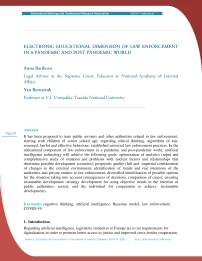Electronic educational dimension of law enforcement in a pandemic and post-pandemic world
Автор: Barikova A.
Журнал: Science, Education and Innovations in the Context of Modern Problems @imcra
Статья в выпуске: 2 vol.4, 2021 года.
Бесплатный доступ
It has been proposed to train public servants and other authorities related to law enforcement, starting with children of senior school age, regarding critical thinking, algorithms of fair, reasoned, lawful and effective behaviour, established universal law enforcement practices. In the educational component of law enforcement in a pandemic and post-pandemic world, artificial intelligence technology will achieve the following goals: optimization of analytics (rapid and comprehensive study of situation and problems with unclear factors and relationships that determine possible development scenarios); prognostic quality (full and impartial consideration of changes in the external environment, identification of trends and real intentions of the authorities and private entities in law enforcement; diversified identification of possible options for the situation taking into account consequences of decisions, comparison of cases); ensuring sustainable development (strategy development for using objective trends in the interests of public authorities, society and the individual for cooperation to achieve sustainable development).
Cognitive thinking, artificial intelligence, Bayesian model, law enforcement, COVID-19
Короткий адрес: https://sciup.org/16010092
IDR: 16010092
Текст научной статьи Electronic educational dimension of law enforcement in a pandemic and post-pandemic world
Regarding artificial intelligence, legislative initiatives in Europe are to set requirements for digitalisation in order to promote better access to justice and improved cross-border cooperation.
Science, Education and Innovations in the context of modern problems, 05 NOV, 2021 Baku, International Conference

Appropriate safeguards are needed to guarantee protection of fundamental rights, including equal treatment and data protection, and to ensure the responsible, human-centric development and use of AI tools where it is in principle appropriate. However, the final decision-making must remain a human-driven activity and decision (Digitalisation of justice, 2020). China hopes artificial intelligence can help streamline court procedures and boost judicial credibility (Lau, 2021).
Within this research, a primary idea is that the Internet must contribute to legal education (Plotnikov, 2019), taking into account the case study as a method in legal education (Afanasieva, 2019):
In this process, the prospects for using artificial intelligence are obvious. Inclusive AI education and training, in order to ensure that AI is non-discriminatory and inclusive, prepares for socioeconomic changes by encouraging modernisation of education and training systems, nurturing talent, anticipating changes in labour market, supporting transitions and adaptation of social protection systems. The European Institute of Innovation and Technology will integrate AI across curricula in the education courses it supports, in order to contribute to developing a talent pool for AI in Europe (Communication, 2018).
Potential benefits of AI for our societies are indisputable to better education. The legal framework will apply to both public and private actors inside and outside the EU as long as the AI system is placed on the Union market or its use affects people located in the EU. It can concern both providers and users of high-risk AI systems. High-risk stands for a limited number of AI systems, creating an adverse impact on people's safety or their fundamental rights as protected by the EU Charter of Fundamental Rights. This includes safety components of products covered by sectorial Union legislation. They will always be high-risk when subject to third-party conformity assessment under that sectorial legislation. In order to ensure trust and a consistent and high level of protection of safety and fundamental rights, mandatory requirements for all high-risk AI systems cover the quality of data sets used; technical documentation and record keeping; transparency and the provision of information to users; human oversight and robustness, accuracy and cybersecurity. In case of a breach, the requirements will allow national authorities to have access to the information needed to investigate whether the use of the AI system complied with the law (New rules for Artificial Intelligence, 2021).
The COVID-19 crisis has shown the need for fast development of online public services that allow citizens to deal with the authorities remotely. The pandemic has demonstrated the need for digital skills and has motivated citizens to acquire such skills in order to adjust to teleworking and other ways of digital involvement, such as using digital education methods due to schools and universities lockdown during pandemic (Council conclusions, 2020).
Definitely, strong safeguards are crucial, according to the Communication ‘A European roadmap to lifting coronavirus containment measures’ (Communication– A European roadmap, 2020) of the Commission on a European roadmap to lifting coronavirus containment measures (European roadmap, 2020):
On that basis, we can develop an AI ecosystem that brings the benefits of the technology to the whole of European society and economy for services of public interest, for example by reducing the costs of providing services in education. We need to establish and support through the advanced skills pillar of the Digital Europe Programme networks of leading universities and higher education institutes to attract the best professors and scientists and offer world-leading masters programmes in AI (White Paper, 2020).
The skills of its people are Europe’s strongest asset. In a global race for talent, the European education and training systems and labour markets need to quickly adapt to new and emerging skills needs. This requires high-quality data on qualifications, learning opportunities, jobs and the skill sets of people. Over the past years, the Commission has put in place a range of open standards, reference frameworks and semantic assets to increase data quality and interoperability. E.g. Europass Learning Model; European Qualifications Framework for lifelong learning (EQF); European Skills, Competences, Qualifications and Occupations (ESCO), Digital Competence Framework (DigComp) (Communication, 2020).
The updated Digital Education Action Plan will help make better use of data and AI-based technologies such as learning and predictive analytics with the aim to improve education and training systems and make them fit for the digital age. The Plan will also increase awareness of AI at all levels of education in order to prepare citizens for informed decisions that will be increasingly affected by AI (Communication – Digital Education Action Plan, 2020).
In a pandemic and post-pandemic world, affected by the COVID-19 crisis, with regard to Page 93 electronic education regarding law enforcement, it is considered expedient to create a base of legal positions, which should be integrated in the future into the common cross-border base, according to which the authorities and private entities in law enforcement could be taught to make decisions correctly.
-
2. 2. The state of scientific development of the problem
Law enforcement in a digital era covers the following issues:
dialogue of supranational and national legal systems and methodology (Maydanyk, 2019), perception and introduction of foreign experience in national legislation not rejecting national traditions of legal regulation, and in this aspect the continuity of norms, the doctrines (Sambor, 2019);
activity of the government which is only one of the means of legal support, distinguishing between governmental and non-governmental (public) legal support on the legal provision of IT-sphere (Kharytonov, Kharytonova & Tolmachevska, 2019), cross-border public administration within the electronic state (Barikova, 2016; Melnyk, Barikova, 2019); analysis based on public interest grounds as recognition of transaction null and legal grounds for intervention in activity (Podtserkovnyi, 2019); role of individual empowerment over personal data, the right to erasure personal information with balance between privacy and freedom of expression (Kivalov, 2019);
use of modern digital technologies by states which may involve violation of the fundamental values of a democratic society (Andreichenko, 2019); digital personality (virtual identity),

International Meetings and Conferences Research Association
IMCRA Publications
3. Promotion and justification of the hypothesis
network and social clusters and platforms which formulate new narratives that differ by state, national and common paradigms (Tuliakov, 2019); Internet users and Internet providers, operating with ‘content’ concept (Ennan, 2019; Podolieva, 2019); security of information and infrastructure in the digital environment (Mazurenko, 2019), security and privacy issues as one of the main obstacles for IoT (Dovhan, Bernaziuk, Tkachuk, 2019); justice and objectivity of big data (Savinova, 2019), IT tools for litigation (Zakharov, 2021); domain disputes (Tarasenko, 2019); process of establishing cryptocurrency as a mean of payment for current digital economy (Dyntu, 2019); drones in agriculture (Kharitonova, Pavlyha, 2019), etc.
General methods of logics have been used in this article (analysis and synthesis, induction and deduction, abstraction, generalization), as well as formal and legal ones on the law enforcement component.
Solution trees have been used as a method of studying the relationship in the form of a hierarchical structure (‘tree') between one dependent variable and one or more independent variables. The typology covers: classification trees (on the basis of the categorical target 94 variable, forecast of values of the dependent variable on values of predictors is formed); regression trees based on the quantitative target variable, when values of the dependent variable are classified according to values of predictors in ‘Bayesian Trust Networks’ (Pearls, 1992) for automatic model-to-model transformation (Parasiuk, Yershov, Alieksieienko, 2006).
Regarding law enforcement, the optimal model is dynamic Bayesian networks, in which values of nodes change over time. It is a network that describes the states of a dynamic system for modeling processes that change over time. Their advantage is that they use a tabular representation of conditional probabilities, which facilitates, for example, representation of various nonlinear phenomena (Zweig, 1998). It is assumed that the structure of the model does not change. Usually, model parameters do not change over time, but you could always add additional hidden nodes to the network structure to clarify the description of the current state of the process (Murphy, 2001).
Intelligent agents (IA) based on precedents (Case-Based Reasoning, or CBR), are widely used to solve poorly formalized problems. Precedence-based inference is a method of constructing IAs that make decisions about a current problem based on the search for analogies stored in the
Science, Education and Innovations in the context of modern problems, 05 NOV, 2021 Baku, International Conference


International Meetings and Conferences Research Association
IMCRA Publications
The metric on space of signs has been proposed. In this regard, the point corresponding to the current case is determined, and within this metric is the closest point to it among the points that reflect precedents. Each sign is assigned a weight that takes into account its relative value. The complete degree of closeness of the precedent on all grounds could be calculated using the generalized formula of the form (Lytvyn, 2011)
where – weight of k sign, sim – similarity function (metric), і – the value of the sign for the current cases i and j of the precedent, accordingly. After calculating the degrees of proximity, all precedents are ranked. The current situation refers to the precedent with the highest rank.
Most of existing methods of constructing the structure of Bayesian networks could be divided into two categories (Cheng, Bell & Liu, 1997; Cheng, Greiner, Kelly, Bell & Liu, 2002; Dedabrishvili, 2017): based on estimating functions (search & scoring); based on test for conditional independence (dependency analysis). The algorithm is used on the basis of statistical analysis of data series characterizing the evolution of network variables (Bidiuk, Demkivskyi, 2021; Levenchuk, Bidyuk , 2020; Zgurovsky, Bidyuk, Terentyev, 2008). To explain the procedure of network adaptation, the following notation is to be introduced:
Page 95
Z = {X1,...,Xn} – a set of nodes that is determined by the number of variables in the database; E ={(Xi, X j)| Xi, X j∈Z } – set of network arcs; Xi – node that corresponds to the observation of one variable from the database; BS – structure; D0 – initial database of observations; S0 – structure obtained as a result of pre-batch processing of the database D0; D1 – database of new observations not used in the construction of S0; S1 – structure obtained after adaptation of S0 to new data. The task concerns development of an algorithm for adapting the original Bayesian network G = Z,E with the structure S0, built on the initial base of observations D0, to the new observations D1. An algorithm for adapting the network structure to new data coming in real time is to be implemented, i.e. it is necessary to create an updated network structure S1óD1. In this case, experimental (statistical) data may have an arbitrary distribution of probabilities, and the processes described by this data might be non-stationary. That is a mathematical expectation M[Xi] ≠const with dispersion M{Xi - M[Xi]}2 ≠ const. The essence of analysis of the informational importance of arcs is as follows. At the stage of checking the arcs for the need to remove for each node, the value of Kdelete (S0) is calculated for the current configuration of the set of ancestral nodes, as well as the value delete (1) K Sm- for configurations that are the result of deleting one of M (1≤ m ≤ M) input arcs from the current node. If the condition Kdelete (S-m1) ≤ Kdelete (S0) is met, then the arc remains in the network structure, because the removal of this arc reduces the value of the local quality functional (i.e. for the current node). Otherwise, the arc is entered in the list of arcs to be further checked for removal. The list could be sorted in ascending order delete (1) K Sm-. The list (set) of arcs is analysed sequentially. Further verification is to calculate the value of the local quality functional in the original configuration and the configurations that we obtain when deleting one of the arcs remaining in the list (Bidiuk, Kozhukhivskyi, Kozhukhivska, 2013).
Pr(C | O) = Pr(O | C) ⋅ Pr(C) / Pr(O); (1)
Pr(O | C) = Pr(O|C) = Pr(Wi |C) (2)
where О – object; С – category; W – word (sign); n – number of words (signs); Pr(C) – probability that a randomly selected object falls into a category C; Pr(O) – full probability of the object O appearing; Pr(Wi |C) – conditional probability that in the presence of a word Wi in the description of the object O, object O belongs to the category C.
Regarding the system of artificial intelligence (appropriate base of legal positions for learning to make correct and effective decisions) the main subsystem of analysis should be the following: data processing (modules of data completeness analysis, deleting records with incomplete data, filling in incomplete data, data aggregation); structure construction (calculation modules, search of optimal structure, construction of probabilistic conclusion, checking of presence of instantiated vertices of graphs, construction of table of conditional probabilities, construction of matrix of empirical values, joint distribution of probabilities of all network, construction of probabilistic conclusion).
-
4. Problem solving and conclusions
At the heart of law enforcement, there is cognitive thinking (Drucker, 1986; Mintzberg, 1990). The conceptual structure is based on the content inherent in cognitive models and is a form of representation that carries information related to the conceptual system (Evans, 2009). It is a question of extending the idea of topological types on all areas of semantics: in perception of concepts the person operates not by separate semantic signs, and integral images. The contours, or profiles of these images, allow drawing analogies between different concepts, to compare them, to replace each other in contexts (Talmy, 1978).
In a pandemic and post-pandemic world, use of artificial intelligence software should consider the structures used in the information processing process, taking into account the data acquired through operational activities, i.e. human interaction with external environment in law enforcement. The educational component of law enforcement is to be focused on cognitive structures on quantitative and qualitative grounds. That is, not all experience should be used, but common to law enforcement. The analytical dimension of this process covers the integrated result of research in various subject areas of law enforcement. Even during education of children in senior school, it is necessary to take into account the cognitive thinking approach with an emphasis on the diversified subject dimension of interpersonal relations in the evolutionary dimension. It is necessary to develop skills of an analytical way of representing the object with symbolic formula constructions on the basis of formal logical operations. As a result, a mental model of perception of the world is formed according to the theory of algorithms.

International Meetings and Conferences Research Association
IMCRA Publications
The mental model is directly correlated with the interpreted fragment of reality. This model is independent of language, because its main source is a sensory perception. At the same time, mental models could be transformed according to various tasks, in particular, interpreted linguistically and deduce inferences (Johnson-Laird, 1983). It is necessary to take into account the evolution of theorizing and methodologizing software systems design, indirectness of the system analysis of the subject area (analogue of the theoretical model ‘essence-connection’ in database theory), the introduction of object-oriented design in the tradition of complex science systems, transforming it into science and art; revealing the importance of creating unified representations in Unified Modelling Language (Stankevych, Tiharieva, 2014). It determines the objective and real existence of the system in physical, network and social dimensions. The growth of constructiveness of the subject area is shown in the Methodology of the Unified Process, the transformation of the model of the subject area into the basis of options for using the created system as a form of influence on the social context. This allows to reveal the transition from cognitive thinking to ontological as mechanisms of the knowledge area transgression, in which theorizing and methodologizing design becomes the basis for creating a new social Page 97 functionality (Rubanets, 2008). In the evolutionary paradigm from the understanding of cognitive thinking as adaptive to the environment, the transition to cognitive thinking as a spiritual basis of systemic transformations is inevitable, taking into account the purposeful component of behaviour design, determining the strategic vector of law enforcement development based on theorizing and methodologizing processes:
Mental representations, in particular conceptual structures, are built with the help of executive components, which are semantic features. Acquisition and expression of certain information occurs through selective coding, which highlights the most important information for a particular purpose, and selective combination, so that fragments of information could be combined into an internally connected whole. It is about perception and transmission of information, combining it into a single whole, its correlation with the previously known person relying on previous experience, which is summed up under certain scenarios, frames, domains, schemes. Despite the universality of the ability to cope with novelty and automation of information processing, manifestations of the components of intelligence in empirical experience depend on the cultural context, cognitive thinking abilities of the individual, motivation, values, emotions (Sternberg, 2005).
Therefore, the electronic educational dimension of law enforcement in a pandemic and postpandemic world should take into account encyclopedic knowledge and knowledge gained by human experience, successful cases of law enforcement entities through selective combination (taking into account the comparative semantic, associative, situational categories with content profiling). In this dimension, law enforcement should be limited to logical and legal formalism and utilitarianism. The situation in which humanity finds itself in a pandemic and post-pandemic
Science, Education and Innovations in the context of modern problems, 05 NOV, 2021 Baku, International Conference

world is quite a negative phenomenon, but it might allow us to make a leap in evolutionary development, particularly, in relation to the electronic educational dimension of law enforcement.
As for artificial intelligence in the electronic educational component, affected by the COVID-19 crisis, in law enforcement practice, then based on process, knowledge, decision-making, actor and national security, a new definition of intelligence has been presented:
as characterized by actionable knowledge of foreign / other countries that is disseminated in the form of information towards end users, i.e. decision makers. However, in order to define the term uniformly, it is important to include all Intelligence Studies stakeholders, both those who consider intelligence on the theoretical level and those who are involved in intelligence in practice. The creation of a large base of professional and academic knowledge over which quantitative and qualitative analysis of extracted elements was conducted, as was the case in this research, imposes itself as the most appropriate model for the study of defining intelligence uniformly. Until now, scientific and empirical knowledge has not focused on the unambiguous definition of the term, although this deficiency has often been referred to. One of the possible reasons for this is the lack of understanding of the term itself, as well as the traditions of individual states in conducting the activity (Dokman, 2019).
Thinking about AI decision-making processes as an institution that brings about transformative effects might be a proper way to conduct the activities. As a result, one gains insight into how the cumulative use of automated decision-making processes is likely to impact on individuals and society at large from the vantage point of social justice. Of significance is that there is a parallel between the elements comprising human and the AI decision-making processes. The term AI decision-making system fails to capture this important element. This is because society does not conceive of human beings and their deliberation as a system. However, one can talk about similarities in the decision-making process human beings engage in and the AI systems carry out because human beings develop the AI decision-making process. Given that human beings exercise their judgement in developing AI decision-making processes, it is not surprising that there can be a degree of similarity between human and AI decision-making processes (Krupiy, 2020).
Consequently, in the educational component of law enforcement in a pandemic and postpandemic world, artificial intelligence technology in a short time at a qualitative level will achieve the following program goals: optimization of analytics (rapid and comprehensive study of the situation and problems with unclear factors and relationships that determine possible development scenarios); prognostic quality (full and impartial consideration of changes in the external environment, identification of trends and real intentions of the authorities and private
Science, Education and Innovations in the context of modern problems, 05 NOV, 2021 Baku, International Conference


International Meetings and Conferences Research Association
IMCRA Publications entities in law enforcement; diversified identification of possible options for the situation taking into account the consequences of decisions, comparison of cases); ensuring sustainable development (development of a strategy for using objective trends in the interests of public authorities, society and the individual; formation of clear and transparent mechanisms for the cooperation of the latter to achieve sustainable development).


